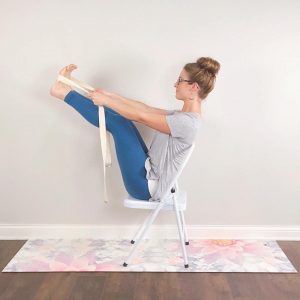Self-compassion and Acceptance | Meet Sarah Matchen
August 3, 2018
Blog post is in collaboration with Accessible Yoga and Yoga International featuring winners of the annual International Day of Yoga Accessible Yoga Instagram Challenge. #IDY2018accessibleyoga
What does accessible yoga look like to you?
Accessible yoga means making yoga available to people who may not have access to it or who may not feel comfortable in mainstream yoga classes. It means welcoming all bodies to the practice, regardless of body type, ability, background or experience, and providing an inclusive, compassionate class environment. Accessibility in yoga also means customizing and adapting poses through the use of variations or props in order to meet people where they are.
 “I’m making yoga accessible by normalizing the use of props and pose variations in asana, and by using inclusive language that focuses on self-compassion and acceptance.
“I’m making yoga accessible by normalizing the use of props and pose variations in asana, and by using inclusive language that focuses on self-compassion and acceptance.
My name is Sarah, I’m from Illinois, and this is what a yogi looks like.”
How did yoga find you?
I first tried yoga as a teenager, borrowing my mom’s yoga mat and following along with one of her yoga DVD’s in our living room. To this day, my practice is almost completely home-based. After coming back to yoga on and off throughout my teens and early 20’s, I became dedicated to the practice in my mid 20’s as a way to help manage anxiety. Through yoga, I have come to hold a deep reverence for slowing down, resting and relaxing. Yoga is my journey inward; a time of quiet and of remembering the goodness and wholeness that already exists within.
In 2017, I completed my 200-HR teacher training with Brett Larkin. Both my teaching and personal practice are breath-centric and meditative, with an emphasis on relaxing the body and observing the mind. I am passionate about sharing how yoga can be accessible to all bodies and am also a big advocate for using yoga props. Yoga has changed my life in many ways, and I am so grateful to be able to share this transformative practice with others.
Who are your accessible yoga role models?
There are so many people I admire who are doing amazing things to make yoga more accessible! To name a few – Jivana Heyman, Dianne Bondy, and Dana Falsetti are all incredibly inspiring to me. They know what they stand for and share their messages with authenticity, respect, and humility. They are powerful examples for me of what it looks like to act from a place of service and a true desire to create a more inclusive yoga culture.
Accessible yoga looks like approaching the practice from a place of curiosity rather than expectation, and observation rather than judgement.
It is using yoga as a tool for introspection and empowerment, as well as for creating a relationship with yourself that is rooted in compassion. We are all so unique as human beings, and the beauty of yoga is that it can be practiced by each one of us if given the right opportunities, environment and tools. As yoga practitioners and teachers, I believe we all have a responsibility to welcome everyone to the practice who is interested and to support each other on our yoga journeys. In doing so, we come to embody the union and connection that is the core of yoga.

Sarah is a 200-hour certified yoga teacher. She teaches meditative, breath-centric yoga classes that emphasize slowing down, calming the mind and relaxing the body. She also loves to incorporate yoga props and pose variations into her classes to help make yoga postures more accessible. Sarah lives in Illinois with her husband and their two rescue dogs. Learn more at sarahmatchenyoga.com.
